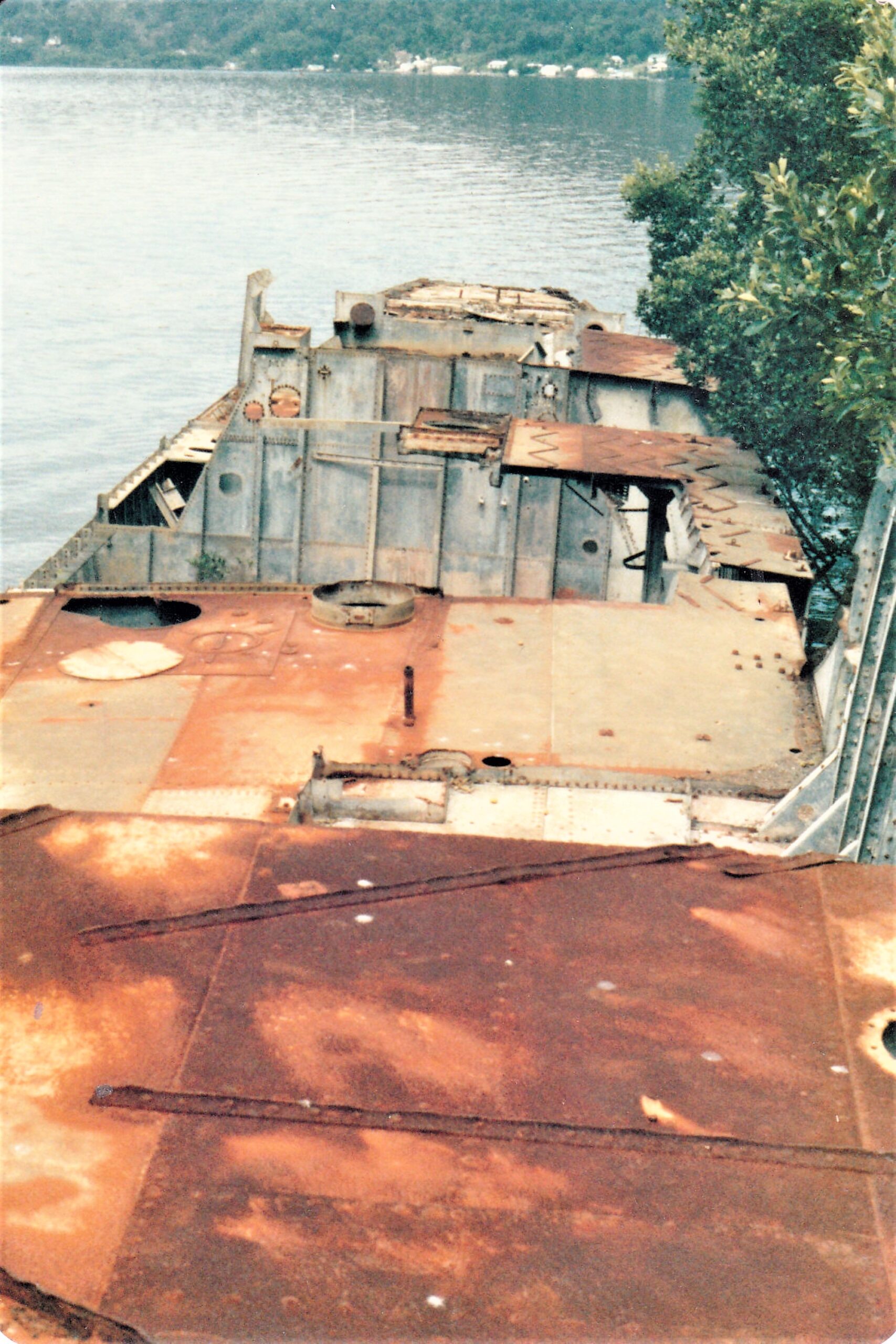By Ross Gillett
The unusual post-war career of the first Australian destroyer
The first HMAS Parramatta, a River class torpedo boat destroyer (TBD), was commissioned into the Australian Fleet in 1910, but ended her days in the Hawkesbury River, north of Sydney, as an abandoned hulk. Along with her sister ship HMAS Swan, the two vessels were taken over by the NSW Government in December 1929 for use as prison accommodation hulks for the construction of a new 25-mile roadway along the foreshores of Kuring-Gai Chase.
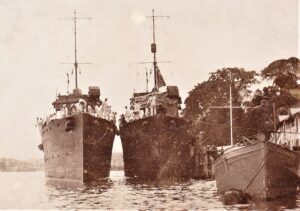
Parramatta had been paid off from naval duties on 20 April 1928, and on 17 October 1929 was handed over to Cockatoo Dockyard for dismantling. The stripped hulls of Parramatta and Swan were to be employed by the NSW Department of Prisons, with approval having been granted by the State Minister of Justice, Mr. Lee, to use the old warships as floating camps in the building of the new scenic drive along Cowan Creek. The road was to start at Brooklyn, head south to Jerusalem Bay and then follow Cowan Creek down into Bobbin Head (refer map).
Accommodation and employment
On 19 February 1930, The Sun newspaper in Sydney reported on this new State Government initiative to begin in middle of the Great Depression:
Gaol Labour to build Scenic Drive
At one stroke, so to speak, the State prison authorities hope shortly to overcome two of their major problems: accommodation and employment. The scheme is to construct a 25-mile roadway along the Kuring-Gai Chase, foreshores, from Brooklyn to Bobbin Head, with prison labour. Cabinet has already approved the scheme and has voted funds to put it into early operation.
To carry out the project, the old destroyers Swan and Parramatta have been saved from the scrapheap and will be converted into floating camps in which the prisoners will be housed. To start with, 50 men will be employed, but later the number will probably be increased to 100. The cost to the State, it is claimed, will be next to nothing, but the benefits to public and prisoners alike will be inestimably great.
Although the Kuring-Gai Chase Trust has disapproved the scheme, they were not fully seized with all the facts. The Minister of Justice (Mr. Lee), who is administrative head of the Prisons Department invited them to meet him tomorrow afternoon to hear the whole of the case for the construction of the road.
What I want to do is to get these young prisoners out in the open air and give them some capacity for work, says the Minister. In that way. I believe, lies their surest way to reform, I must say, frankly, that I regard the road itself as a secondary, but still important consideration.
The work on the Kuring-Gai Chase road will be largely labouring, but, after studying it from every angle, I claim that by constructing it with prison labour we won’t be taking the pick and shovel out of any man’s hand. This road will never be built in any other way, so far as I can see, it will add to the national assets one of the best scenic drives in the world – certainly better than anything there is in Australia today.

After two days of cruising round (Sydney) harbour looking for suitable hulks, Mr. Lee, more by accident than not, came upon the two destroyers waiting to be broken up. They might have been made to order for the purpose he had in mind, so easily can they be adapted to housing prisoners. The cost of the two of them was, he says, ridiculously low.
It is proposed to light up the old destroyers with huts similar to those built at the afforestation camps, each man will have a separate compartment. The hulks will move along with the job. Launches will take the men to and from the shore, with the utmost possible security against escape… and there will be the added attraction of fishing and swimming during the hours off duty.
Short tow north
The old Parramatta was towed from Sydney at sunset on 15 August 1930, bound for Broken Bay. But despite the previously announced grand plans for the two ships and the intended delivery of a wonderful 28 feet wide scenic roadway, the Kuring-Gai Chase Trust again turned down the proposal, despite having earlier raised no objections to the project. The proposed road would have presented no major engineering difficulties, and not one penny would have been required, except for explosives and labour.
Plan B
On 17 February 1931, Sydney’s Daily Telegraph newspaper reported on the fate of the two veterans of the Great War.
Warships for Sale
The second-hand warship market has been badly hit by the depression, and the State Government has two vessels on its hands for which it will not reject any reasonable offer.
They are the ex-destroyers Parramatta and Swan, which were purchased from the Commonwealth by the Bavin (State) Government for use as floating prisons in Cowan Creek. The present Minister, Mr Lamaro, has been playing with the idea of utilising the hulks, but he has now come to the conclusion that the Government’s policy will not allow him to do so.
If anybody wants a destroyer – minus armament – now is the time to secure one ‘dirt-cheap.’
Although a gang of convict carpenters had begun the task of converting the ships into prison hulks, work was soon abandoned. The State Government still hoped that the Kuring-Gai Chase Trust would purchase the vessels for conversion into ‘large’ houseboats, but some contemporary commentators described the 21-year-old hulls as not very suitable for such a purpose.
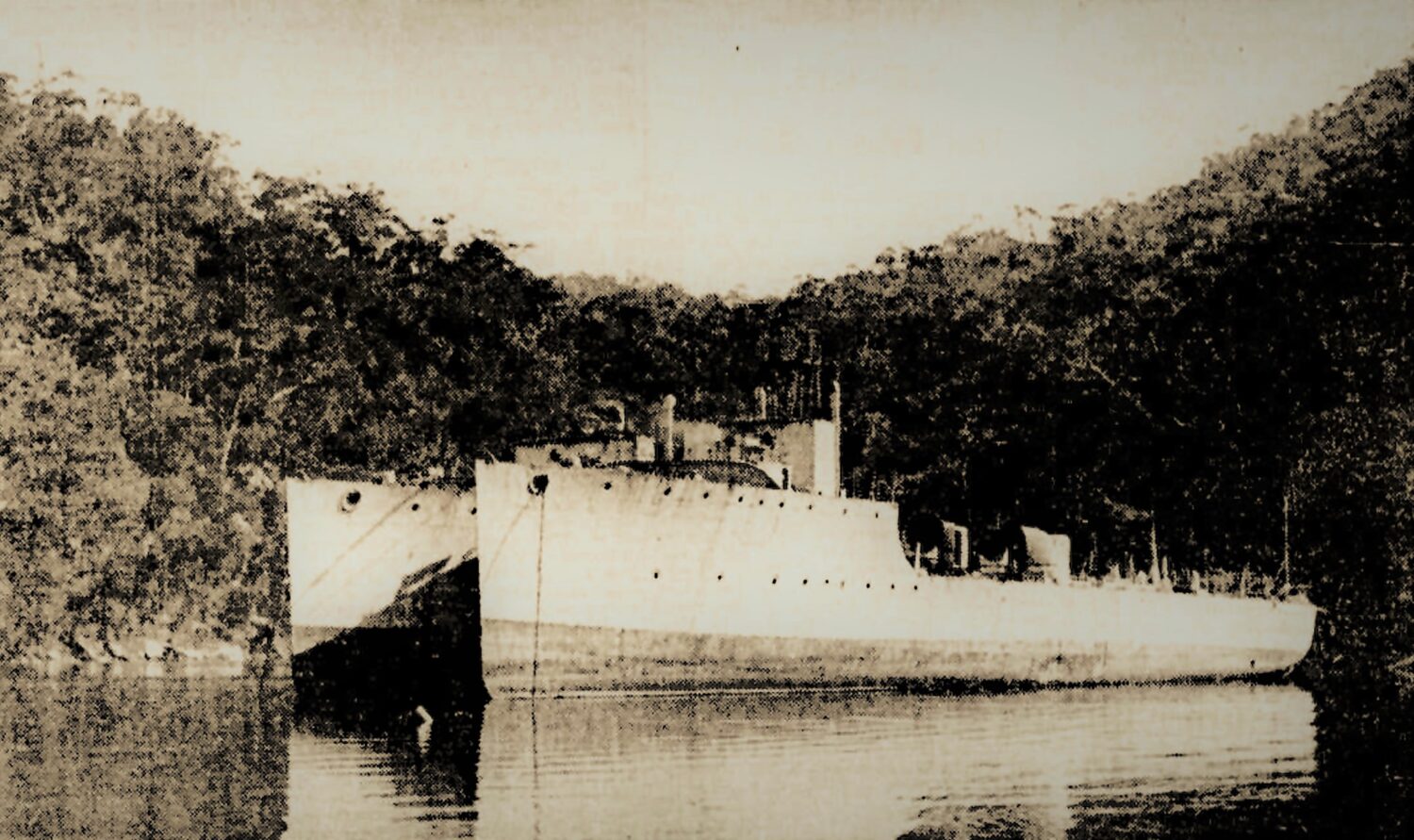
Nine days later, the Melbourne based weekly magazine Table Talk reported further on the old destroyers:
Warships go Begging
Anyone anxious to solve the rent problem round Sydney way might inspect the two ex-destroyers, Parramatta and Swan, which the NSW Government would be glad to part with. The hulks are now on the market as houseboats. Sydneyites are not indulging in houseboats to any great extent, and as they would be useless to the homeless unless they could tow them alongside the Relief Department, it looks as if the hulks might have to go the way of all war junk, to the bottom of the sea.
Where were the two destroyers?
Tenders were called for the sale of the two hulks on 12 May 1931, and in the following November, both were put up for sale by the New South Wales Government. George Rhodes, a boatshed owner on Cowan Creek, bought the two ships for £12 each. Rhodes ran them aground in Jerusalem Bay, intending to use them as accommodation for weekend fishermen, although another report claims they were to be employed as blue-metal storage barges. The Ku-ring-gai Chase Trust did not approve his accommodation project and the vessels were resold in 1934, this time to people who wanted to employ them to transport materials to Milson Island.
Parramatta’s hulk was sold again, this time to local marine engineer Mr. Norman Murphy, as water storage for residents during the ongoing depression.
Tows lost
But how did the TBD Parramatta end up where she is today?
Most reports from available historical publications, as well as the official RAN records, indicate that after the failure of the plan to employ Parramatta and her sister ship Swan as accommodation hulks in Cowan Creek, the two ships were being towed DOWN RIVER, bound for Sydney on 2 February 1934 when a major storm developed. Due to the conditions the tow to both ships was lost and as a result Swan sank off Wobby Beach in the Hawkesbury River, close to the old railway bridge, and Parramatta was pushed ashore opposite the northern end of Milson Island.
This writer considers that towed ‘down river’ means being shifted from Cowan Creek, a tributary of the Hawkesbury River. So, when the storm came up the two TBDs were passing the eastern entrance to the river (between Juno Point and Eleanor Bluffs) and were thus pushed further, in a north-west direction. Swan would have sunk first, near the bridge, but Parramatta continued to drift in heavy winds, past the eastern side of Milson Island and then onto a mudflat on the shore at Cascade Gully, where she has laid ever since.
After losing their tow both hulks would have had to drift around several bends in the river, pass Dangar Island, and in the case of Parramatta, past a bridge, the vehicular ferry and onto Cascade Gully.
Before 1934 there is no mention of the two ships in the river, just Cowan Creek or Jerusalem Bay, from where the final tow would have started.
First preservation plan
The hull of the 1910 vintage Parramatta lay silent for many more decades, visited only by curious boat owners and holiday makers during their voyages up and down the Hawkesbury River and the many nearby creeks. Squatters allegedly lived aboard of the TBD during subsequent years.
Parramatta remained on the bank at Cascade Gully, more or less forgotten, until the mid-1930s when several RAN men who had served on her during the war paid her a visit of respect and once again trod her decks. And as the old, neglected warship lay there in the silence of the bush those men had vivid memories of all she had once meant to them and to all the 80-man crew who lived aboard in such close quarters. There and then they decided to form a committee of former RAN destroyer men and to hold an annual reunion. The Second World War came and went, and now, there were fewer still to remember and care about the old wreck on the riverbank. But those who remained did remember.
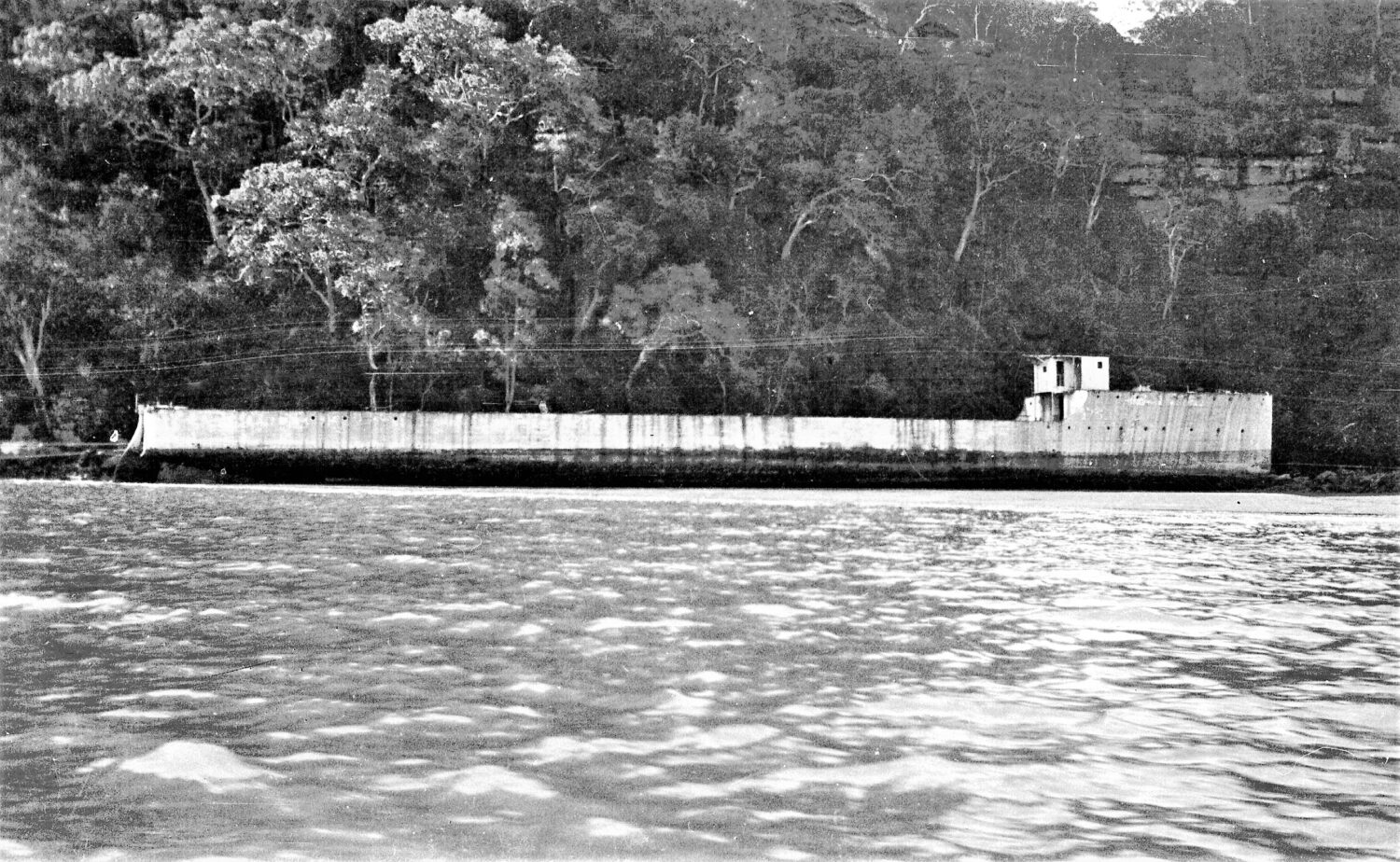
In the early 1950s those members of the Parramatta Association began enquiries into the feasibility of rescuing their old warship, a vessel that had served the navy and the nation so well, including much service in the Great War.
In the early 1950s, an Electrical Trades Union representative, Mr Guy Anderson, was interviewing Navy Minister William McMahon about an industrial matter. Both fell to talking about the Navy, and Mr Anderson asked Mr McMahon on behalf of the association of old destroyer men if he could do something about the old ship – move her and turn her into a naval museum. Mr McMahon gave no undertaking but said casually he would see what could be done. A few days later, members of Parramatta‘s old crew learned that Mr McMahon had asked his staff to find out whether the warship could be moved and how much it would cost to shift her.
Interest in the proposal to bring the old TBD back to her original homeport of Sydney gained further momentum on 22 June 1952 when the Sun newspaper reported on such plans:
Old ship may come home
The hull of the first warship built for the Royal Australian Navy, the 700-ton torpedo boat destroyer Parramatta, may soon be moved from the bank of the Hawkesbury, near Brooklyn, where it has lain neglected for 22 years. Recently a committee of ex-RAN men, including some who sailed in Parramatta before and during the First World War, decided that the old ship should not be allowed to rust into oblivion. They would like to see her towed from the Hawkesbury into the Parramatta River, after which she was named, and there established as a RAN memorial and national Navy museum. They have already asked Navy Minister McMahon to have this done and Mr. McMahon has called for a report from naval architects. Naval architects will inspect Parramatta carefully before making their report. An unofficial survey suggests that the historic destroyer could be moved to the Parramatta River for about £5000.
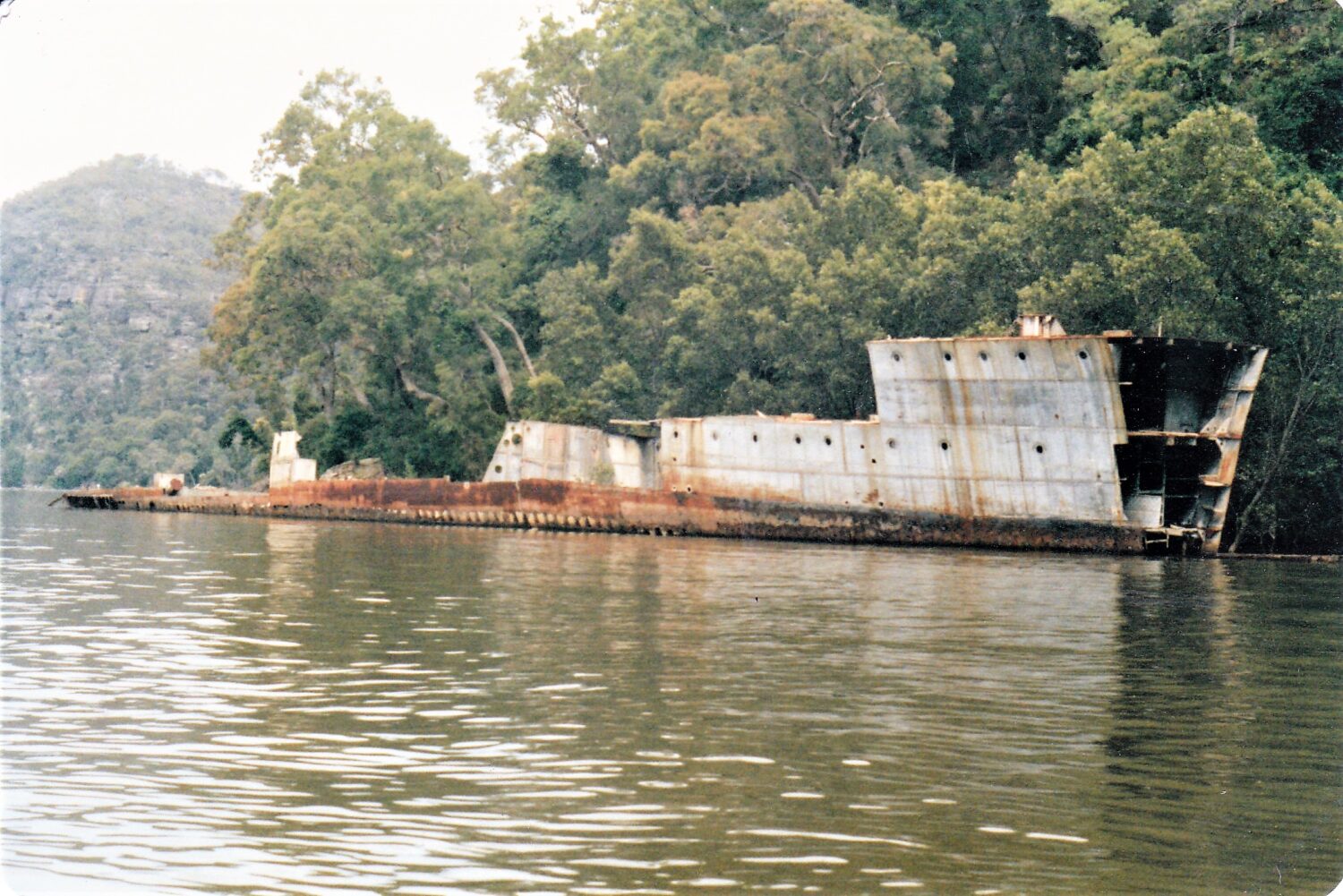
Despite raising this matter of preservation as far as the Federal Government the project failed to receive approval, and Parramatta remained largely forgotten for another 20 years.
More recent times
In 1972, the Naval Historical Society of Australia began their own project to recover the bow and stern for a memorial to the vessel and its later namesakes, Parramatta (II) and Parramatta (III). This time however the project developed much faster and soon engineers visited the location to approve the scheme to remove parts of the old warship. On 7/8 July 1973 Parramatta’s bow and stern sections were salvaged and later transported to a site on the north bank of the Parramatta River, upstream from the Silverwater Bridge. However, funding, and other constraints delayed the project. Then, in 1981 the stern was mounted at a new naval memorial in Queens Wharf Reserve, Parramatta and in 1986, the bow section was installed at the northern end of Garden Island, Sydney, within the grounds of the Naval Heritage Centre.



